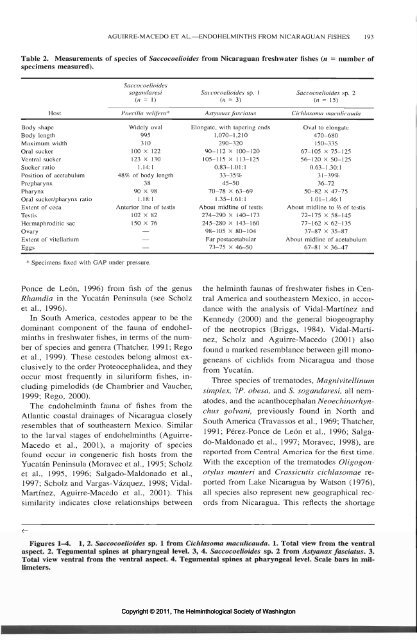Comparative Parasitology 68(2) 2001 - Peru State College
Comparative Parasitology 68(2) 2001 - Peru State College
Comparative Parasitology 68(2) 2001 - Peru State College
You also want an ePaper? Increase the reach of your titles
YUMPU automatically turns print PDFs into web optimized ePapers that Google loves.
AGUIRRE-MACEDO ET AL.—ENDOHELMINTHS FROM NICARAGUAN FISHES 193<br />
Table 2. Measurements of species of Saccocoelioides from Nicaraguan freshwater fishes (n = number of<br />
specimens measured).<br />
Host<br />
Body shape<br />
Body length<br />
Maximum width<br />
Oral sucker<br />
Ventral sucker<br />
Sucker ratio<br />
Position of acctabulum<br />
Prepharynx<br />
Pharynx<br />
Oral sucker/pharynx ratio<br />
Extent of ceca<br />
Tcstis<br />
Hermaphroditic sac<br />
Ovary<br />
Extent of vitellarium<br />
Eggs<br />
Saccocoelioides<br />
sogandaresi<br />
(n = 1)<br />
Poecilia velifera*<br />
Widely oval<br />
995<br />
310<br />
100 X 122<br />
123 X 130<br />
1.14:1<br />
48% of body length<br />
38<br />
90 X 98<br />
1.18:1<br />
Anterior line of testis<br />
102 X 82<br />
150 X 76<br />
—<br />
—<br />
—<br />
Specimens fixed with GAP under pressure.<br />
Ponce de Leon, 1996) from fish of the genus<br />
Rhamdia in the Yucatan Peninsula (see Scholz<br />
et al., 1996).<br />
In South America, cestodes appear to be the<br />
dominant component of the fauna of endohelminths<br />
in freshwater fishes, in terms of the number<br />
of species and genera (Thatcher, 1991; Rego<br />
et al., 1999). These cestodes belong almost exclusively<br />
to the order Proteocephalidea, and they<br />
occur most frequently in siluriform fishes, including<br />
pimelodids (de Chambrier and Vaucher,<br />
1999; Rego, 2000).<br />
The endohelminth fauna of fishes from the<br />
Atlantic coastal drainages of Nicaragua closely<br />
resembles that of southeastern Mexico. Similar<br />
to the larval stages of endohelminths (Aguirre-<br />
Macedo et al., <strong>2001</strong>), a majority of species<br />
found occur in congeneric fish hosts from the<br />
Yucatan Peninsula (Moravec et al., 1995; Scholz<br />
et al., 1995, 1996; Salgado-Maldonado et al.,<br />
1997; Scholz and Vargas-Vazquez, 1998; Vidal-<br />
Martinez, Aguirre-Macedo et al., <strong>2001</strong>). This<br />
similarity indicates close relationships between<br />
Saccocoelioides sp. 1<br />
(n = 3)<br />
Astyanax fasciatus<br />
Elongate, with tapering ends<br />
1,070-1,210<br />
290-320<br />
90-112 X 100-120<br />
105-115 X 113-125<br />
0.83-1.01:1<br />
33-35%<br />
45-50<br />
70-78 X 63-69<br />
1.35-1.61:1<br />
About midline of testis<br />
274-290 X 140-173<br />
245-280 X 143-160<br />
98-105 X 80-104<br />
Far postacetabular<br />
73-75 X 46-50<br />
Saccocoelioides sp. 2<br />
(« = 15)<br />
Cichlasoma maculicauda<br />
Oval to elongate<br />
470-<strong>68</strong>0<br />
150-335<br />
67-105 X 75-125<br />
56-120 X 50-125<br />
0.63-1.30:1<br />
31-39%<br />
36-72<br />
50-82 X 47-75<br />
1.01-1.46:1<br />
About midline to % of testis<br />
72-175 X 58-145<br />
77-162 X 62-135<br />
37-87 X 35-87<br />
About midline of acetabulum<br />
67-81 X 36-47<br />
the helminth faunas of freshwater fishes in Central<br />
America and southeastern Mexico, in accordance<br />
with the analysis of Vidal-Martinez and<br />
Kennedy (2000) and the general biogeography<br />
of the neotropics (Briggs, 1984). Vidal-Martinez,<br />
Scholz and Aguirre-Macedo (<strong>2001</strong>) also<br />
found a marked resemblance between gill monogeneans<br />
of cichlids from Nicaragua and those<br />
from Yucatan.<br />
Three species of trematodes, Magnivitellinum<br />
simplex, IP. obesa, and S. sogandaresi, all nematodes,<br />
and the acanthocephalan Neoechinorhynchus<br />
golvani, previously found in North and<br />
South America (Travassos et al., 1969; Thatcher,<br />
1991; Perez-Ponce de Leon et al., 1996; Salgado-Maldonado<br />
et al., 1997; Moravec, 1998), are<br />
reported from Central America for the first time.<br />
With the exception of the trematodes Oligogonotylus<br />
manteri and Crassicutis cichlasomae reported<br />
from Lake Nicaragua by Watson (1976),<br />
all species also represent new geographical records<br />
from Nicaragua. This reflects the shortage<br />
Figures 1—4. 1, 2. Saccocoelioides sp. 1 from Cichlasoma maculicauda. 1. Total view from the ventral<br />
aspect. 2. Tegumental spines at pharyngeal level. 3, 4. Saccocoelioides sp. 2 from Astyanax fasciatus. 3.<br />
Total view ventral from the ventral aspect. 4. Tegumental spines at pharyngeal level. Scale bars in millimeters.<br />
Copyright © 2011, The Helminthological Society of Washington
















